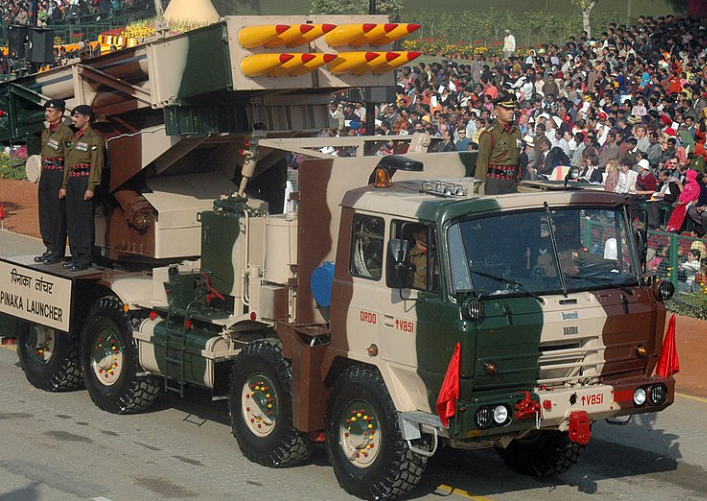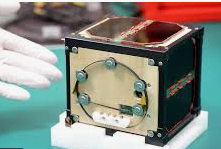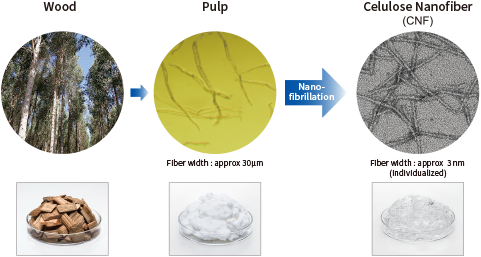Pinaka Multi-Barrel Rocket Launcher
France is considering India’s Pinaka Multi-Barrel Rocket Launch (MBRL) system for its requirements.
- Pinaka Multi Barrel Rocket Launcher (MBRL) – It is a battle-proven an all-weather, indirect area fire Artillery Weapon System.
- Designed by - Defence Research and Development Organisation
- Characteristics
- Maximum Range
- Mark-I Enhance - 45 km
- Mark-II ER version - 90
- Shoot & Scoot Capability with Auto Levelling / Stabilisation
- Salvo of 12 Rockets in 44 Seconds
- Position accuracy of one milliradian for AZ and EL
- Programming all 12 Rockets in max. 20 seconds
- Onboard Inertial Navigation System for Accurate and Speedy Laying
- It can fire a variety of ammunition

- The Indian Army has four Pinaka regiments in service and six more are on order.
- Armenia became the first export customer for the indigenously developed Pinaka
Reference
The Hindu | Pinaka Rocket System
Lignosat
Recently, the world’s first wood-panelled satellite was launched into space by the Japanese spacecraft.
- Aim - To test the durability of wood in extreme temperatures.
- To test the reliability of timber as a renewable building material for future space travel.
- Developed by - Kyoto University and logging firm Sumitomo Forestry.
- Duration - It will be released into orbit above the Earth, and will remain in orbit for six months.
- Properties
- It is a small, palm-sized satellite.
- It measures just 4 inches (10 centimeters) on each side, and weighs 900 grams.
- It is made from Honoki Wood, a type of magnolia tree native to Japan.
- It is not entirely made of wood
- Aluminium structures and electronic components are also used in a wood panel casing.

- Launched by - Space X’s Falcon 9 Block 5 rocket.
- Tests to be conducted
- Durability of wood in the extreme environment of space where temperatures fluctuate from 100 to 100 degrees Celsius every 45 minutes.
- Timber’s ability to reduce the impact of space radiation on semiconductors.
- Changes in the wood's structure, integrity, and resilience.
- Benefits of Wooden Satellite
- Wood is more durable in space than on Earth because there’s no water or oxygen that would rot or inflame it.
- Wooden made satellite is a renewable solution for a long-term.
- It wouldn’t introduce any damaging pollutants like aluminum oxides into the atmosphere when it falls back to Earth.
- It will be minimising the risk to active satellites, space stations, and astronauts.
Reference
The Indian Express| Lignosat
1GeV Particle Accelerator
The Department of Atomic Energy plans to build a 1 giga-electron volt (GeV) particle accelerator.
- Particle Accelerator – It is a machine that uses electromagnetic fields to propel charged particles like electrons, protons and neutrons to very high speeds and energies to contain them in well-defined beams.
- Function - Subatomic particles are shoot on to target or made to collide with each other.
- Applications
- Fundamental research in particle physics
- Used as synchrotron light sources for the study of condensed matter physics.
- Particle therapy for oncological purposes.
- Radioisotope production for medical diagnostics.
- Ion implanters for the manufacture of semiconductors.
- Accelerator mass spectrometers for measurements of rare isotopes such as radiocarbon.
- India has many particle accelerators (cyclotrons and synchrotrons) in the range of upto 30 MeV but none are in the GeV range.
|
Accelerators in India
|
|
Accelerators
|
Location
|
Applications
|
|
10 MeV electron RF LINAC
|
Bhabha Atomic Research Centre, Mumbai
|
- Photo-fission
- Nuclear data
|
|
3 MeV electron DC Accelerator
|
Bhabha Atomic Research Centre, Mumbai
|
- Food processing
- Industrial applications
|
|
6 MeV electron RF LINAC
|
Bhabha Atomic Research Centre, Mumbai
|
|
|
16.5 Medical cyclotron
|
Bhabha Atomic Research Centre, Mumbai
|
- Isotope Production and PET
|
|
Variable energy cyclotron
|
Variable Energy Cyclotron Centre, Kolakata
|
- Research in basic and applied nuclear sciences
|
|
Synchrotron Radiation Source INDUS-I & II
|
Raja Ramanna Centre for Advanced Technology, Indore
|
|
|
Microtron Accelerator (8MeV)
|
Mangalore University
|
- Photo-fission
- Neutron source
|
|
Low energy cyclotron (2-3MeV proton)
|
Panjab University, Chandigarh
|
|
- 1 GeV particle accelerator — It is a continuous wave, high-intensity proton accelerator that will help convert thorium, abundantly available in India, into uranium-233 nuclear fuel.
- Other Methods of Leveraging Thorium
- Fast-breeder Reactor - Breeding uranium-233 by irradiating thorium in a nuclear reactor.
In a fast-breeder reactor, one can produce more fissile material than what is consumed.
-
- Burn up Configuration - Using thorium along with uranium in in a reactor to derive surplus energy from thorium through in situ fission of generated uranium-233.
Reference
Business Line | 1 GeV particle accelerator
Cellulose Nanofibers
A recent study has aimed to create hydrophobic paper by exploiting the mechanical properties and water resistance of cellulose nanofibers.
- Cellulose nanofibers (CNFs) – They are tiny elements of cellulosic material with diameters of the order of 15–20 nm.
Cellulose is the most abundant renewable organic compound that is structural component of the cell walls of natural plant bodies.
- They are extracted from agricultural resources such as soy, wheat, corn, beet and biomass.

- Appearance - It exist in the form of bundles of cellulose microfibrils, a main component of plant and wood pulp fibers.
- Properties
- Large surface area-to-volume ratio
- High strength and versatility
- Good mechanical properties
- Very low coefficient of thermal expansion
- Not soluble in aqueous solutions
- High level of crystallinity
Crystallinity refers to the degree to which a material or substance is composed of ordered, i.e. repeating arrangements of atoms or molecules in a crystalline lattice structure.
- Applications - Cellulose nanofibers have a broad range of applications in areas as food industries, medicine and so forth.
- Uses in tissue engineering, wound healing, medical implants and delivery of bioactive molecules.
- Freeze-dried nanocellulose as aerogels are employed in napkins with sanitation purposes, diapers and wound dressing.
- Composite coating agent in cosmetics
- Tablets for treating intestinal disorders
- Used as low-calorie replacements for carbohydrate additives
- Reinforcing elements in plastics and polymer nanocomposites.
References
- Phys | Hydrophobic cellulose
- Science Direct | Cellulose Nanofibers
EV as a Service' Programme
Recently Union Minister of Power and Housing & Urban launched 'EV as a Service' programme.
- EV as a Service – It is a subscription-based access to electric vehicles, eliminating the high upfront costs of purchasing an EV.
- Aim - To boost e-mobility in government offices to deploy 5,000 E-Cars in government departments over the next two years.
- Advancing the adoption of electric cars in Central and State Government ministries/departments, CPSE’s and institutions.
- Nodal Agency - Convergence Energy Services Limited (CESL), a subsidiary of Energy Efficiency Services Limited (EESL).
- Flexible procurement model - Govt. offices can choose E-Cars that best align with their operational requirements.
- Benefits
- Supports the government’s environmental sustainability vision.
- Aligns with India’s ambitious goal of achieving net zero emissions by 2070.
- Cuts carbon emissions
- Reduces reliance on fossil fuels
- Bolsters India’s energy security
- CESL has already deployed nearly 2000 nos. of E-Cars across India and is also facilitating the deployment of approx. 17,000 E-Buses.
|
Convergence Energy Services Limited (CESL)
|
- Convergence – It is a green energy focused subsidiary venture of Energy Efficiency Services Limited (EESL).
- Functions
- It offers interventions to solve multiple gap areas in the energy ecosystem by amalgamating independent sectors such as electricity, transport, home appliances.
- It introduces models for adaptation at scale through government partnerships and innovative financing such as carbon markets.
|
PM Electric Drive Revolution in Innovative Vehicle Enhancement (PM E-DRIVE)
- Aim- To accelerate EV adoption and establish essential charging infrastructure across the country, promoting cleaner and more sustainable transportation.
- Financial outlay – Rs. 10,900 crore over a period of 2 years.
- Nodal Ministry - Ministry of Heavy Industries (MHI)
- E-Vouchers – It facilitates accessing incentives by consumers, providing a seamless experience for both consumers and manufacturers.
- The scheme portal will generate an e-KYC Aadhaar FACE authenticated e-Voucher for the customer at the time of purchase.
- A link to download the e-Voucher shall be sent on the registered mobile number of the customer.
- Eligible EV Categories under the scheme
- e-2 Wheelers (e-2Ws)
- e-3 Wheelers (e-3Ws) including registered e-rickshaws & e-carts and L5
- e-Ambulances
- e-Trucks
- e-Buses
- Charging infra
- Upgradation of Testing Agencies
References
- PIB | EV as a Service
- PMEDrive | PMEDrive


